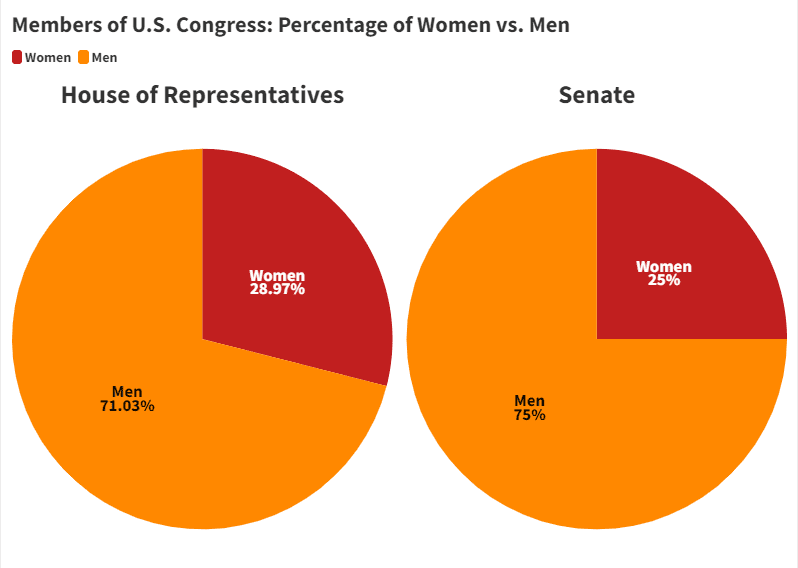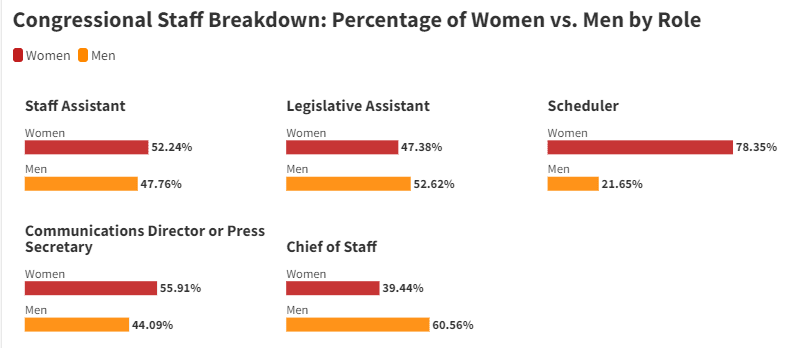Despite decades of continued progress and almost two centuries of activism for women’s rights, glass ceilings and achievement gaps still exist, preventing true equality based on sex, as well as other factors such as race, national origin, disability, etc.
While glass ceilings, achievement gaps, and inequal political representation remain issues in need of constant progress, there has been significant headway in comparison to recent decades and centuries.
According to the Center for American Women and Politics, in 2024, women make up just 28.2% of the U.S. Congress, comprising just 151 out of 535 total seats. The U.S. House of Representatives reflects a slightly higher level of diversity in terms of political representation on the basis of sex, with 29% of Members being women, while women make up only 25% of the U.S. Senate.

At the Federal level, women in positions of power are even fewer than in the Legislative Branch. Vice President Kamala Harris is the first woman to hold the office of Vice President, as well as the first woman of color. A woman has not yet been elected President of the United States, despite Hillary Clinton’s near-win as the Democratic Nominee against Donald Trump in the 2016 presidential election.
In the Judicial Branch, woman hold mere representation compared to men. Out of the 116 total U.S. Supreme Court Justices since 1789, only six Justices are or were women, with four currently serving and two retired or deceased. This means that only 5.17% of all U.S. Supreme Court Justices are women over the course of 235 years.
At the State level, women are continuously increasing political representation in comparison to men. Currently, women make up 24% of Governors and 51.2% as Lieutenant Governors across the 50 U.S. States. Out of the 7,000+ total seats in state legislatures across the country, women account for 32.9% of the representation. Additionally, at the local level, women make up 34% of Mayors across the 100 most populous U.S. cities.
While these numbers may reflect a concerningly low level of political representation for women, the U.S. and the rest of the world has made considerable progress in terms of minority rights in comparison to past decades and centuries.
Background and Historic Policies
Did you know that the earliest traces of a holiday honoring women date back to 1909 in New York City? While not a formal recognition of women’s history, 1909 symbolizes a significant time when the International Ladies’ Garment Workers’ Union (ILGWU) led a successful strike to push for new laws protecting organized labor. In 1909 and 1910, ILGWU led the “Uprising of the 20,000”, a strike of mostly female shirtwaist makers in New York City, notable for its size, duration, and support from middle-class women. These efforts introduce activism pertaining to women’s rights, in addition to workplace equity for all.
March 8, 1917, marks the first day of the Russian Revolution and the start of the dissolution of the Russian Empire. On this day, thousands of Russian women gathered to protest and go on strike in the capital of Petrograd to demand food and the end of Imperial Russia. As a result, Tsar Nicholas II abdicated the throne. Due to this significant impact, German activist, Clara Zetkin, suggested in 1921 that March 8 be declared International Women’s Day.
Formal recognition of women’s history and rights in the United States initially began at the local level as a week-long celebration in Santa Rosa, California in 1978. The Education Task Force of the Sonoma County Commission on the Status of Women planned the week and timed it with International Women’s Day.
In 1980, President Carter issued the first presidential proclamation designating March 2-8 as “Women’s History Week”. It wasn’t until 1987 that President Ronald Reagan issued the first presidential proclamation to extend the celebration to “Women’s History Month” after Congress passed Public Law 100-9 on March 12, 1987. S.J. Res.20 – Joint resolution to designate the month of March 1987 as “Women’s History Month” was introduced in the first session of the 100th Congress in 1987 and quickly received support to be signed into law. This law called upon all Americans to mark the month with observances to honor the achievements of American women.
Other significant historical policies and legislation that played a positive role in the liberation of women in the U.S. includes, but is not limited to:
- Civil Rights Act of 1964 – Prohibits discrimination on the basis of sex, race, color, religion, and national origin.
- Title VII – As a provision of the Civil Rights Act of 1964, this extends to apply to labor law, making it illegal to discriminate in hiring, promoting, or firing processes in the workplace on the basis of sex, race, color, religion, and national origin. This is a pillar of workplace equality in workplace or labor discrimination law. This law also outlaws the creation of a hostile-work environment based on sex and sexual harassment, as well as discrimination based on gender stereotyping. Before the law’s enactment, it was legal and common for an employer to refuse to hire women.
- Equal Pay Act of 1963 – Made it explicitly illegal to pay women a lower wage than men, simply based on sex. Furthermore, the bill offers a tool for women to either (1) go to court or (2) file a claim with the Equal Employment Opportunity Commission (EEOC) against their employers for unequal pay based on sex.
- Family and Medical Leave Act of 1993 (FMLA) – Under this law, a woman working for a company with 50+ employers can take up to 12 weeks of unpaid leave to care for a newborn or newly adopted child. This was the first bill ever signed into law by President Bill Clinton. Prior to 1993, there was no right to take leave from a company to care for a newborn or adopted child. If you had a baby and needed to take time off, an employer could legally give your job to someone else.
Current Policies/Legislation
Some of the biggest policy and social issues to watch in 2024, and ahead of this year’s presidential election, relate to women’s issues, equity, and rights. One of the most significant and prominent of these issues is reproductive rights. Other health-related issues for women that highlight gender disparities and elicit a call-to-action include improving paid maternity leave and increasing research on diseases that disproportionately affect women more than men.
Out of all legislation introduced in the 118th Congress thus far, there are several key areas of policy issues pertaining women. See below for a breakdown of some of these issue areas as well as some of the current bills within thematic areas:
Reproductive Health and General Health Discrepancies
- H.R. 12 // S. 701 – Women’s Health Protection Act of 2023: Prohibits governmental restrictions on the provision of, and access to, abortion services. With a combined 262 cosponsors, in addition to the two sponsors, Rep. Chu (D-CA-28) and Sen. Baldwin (D-WI), this dual-chamber bill is a comprehensive approach to safeguarding abortion rights and personal decision-making. Rep. Chu states “The Women’s Health Protection Act fights back by creating a federal right to abortion care, free from state-level abortion bans that chip away at reproductive freedom, and by moving us toward a nation of true equality.” – via Press Release, 3/30/23: PRESSLEY, CHU, FRANKEL, ESCOBAR LEAD 204 COLLEAGUES TO INTRODUCE WOMEN’S HEALTH PROTECTION ACT OF 2023
- H.R. 7 // S. 62 – No Taxpayer Funding for Abortion and Abortion Insurance Full Disclosure Act of 2023: Prohibits the use of federal funds for abortions or for health coverage that includes abortions. Restrictions extend to the use of funds in the budget of the District of Columbia. Additionally, abortions may not be provided in a federal health care facility or by a federal employee. Restrictions regarding the use of federal funds do not apply in cases of rape, incest, or where a physical disorder, injury, or illness endangers a woman’s life unless an abortion is performed. The bill also prohibits qualified health plans from including coverage for abortions. Across both chambers of Congress, the bill has 223 cosponsoring Members, all of the Republican party. The dual chamber legislation was introduced in January 2023 and remains on respective committees within the House (Committees on the Judiciary, Ways and Means, and Energy and Commerce) and the Senate (Committee on Finance).
- H.R.4534 // S.2245 – Women and Lung Cancer Research and Preventive Services Act of 2023: Requires the Department of Health and Human Services (HHS) to conduct an interagency review of the status of women and lung cancer. The review must report on the status of existing research and current knowledge gaps and identify new opportunities for collaborative research to determine lung cancer causes, advance prevention, screening, diagnosis, and treatment. Ultimately, the review must provide recommendations for a national cancer screening strategy and public education campaign. This dual-chamber, bipartisan bill has 26 cosponsors in the House and 9 cosponsors in the Senate. In the House, the bill currently sits on the Subcommittee on Health within the House Committee on Energy and Commerce and in the Senate, the legislation awaits further voting on the Senate Committee on Health, Education, Labor, and Pensions.
Honor, Recognition, and Education of Women’s Achievements
- H.R.1318 // S. 886 – Women’s Suffrage National Monument Location Act: Authorizes the location of a monument on the National Mall to commemorate the women’s suffrage movement and the passage of the 19th Amendment to the Constitution. Introduced in March 2023 by Rep. Joe Neguse (D-CO-2) and Sen. Tammy Baldwin (D-WI), the dual-chamber, bipartisan legislation has 49 cosponsors across the Senate and House. H.R. 1318 passed in November 2023 and was sent to the Senate for consideration, while S. 886 was introduced and referred to the Subcommittee on National Parks within the Senate Committee on Energy and Natural Resources, awaiting further action.
- H.R.4273 – LGBTQI+ and Women’s History Education Act of 2023: Directs the National Museum of American History of the Smithsonian Institution (NMAH) to carry out activities to support LGBTQI+ history and women’s history education programs. The bill garners support from 60 Democratic Members of the House and lies on the Committee on House Administration. Specific activities that the NMAH must carry out within this bill include, but is not limited to:
- Engagement with state and local education leaders to encourage the adoption of resources supported under this bill into curricula across diverse disciplines.
- Development, operation, and expansion of a teacher fellowship program to cultivate and support leaders in LGBTQI+ and women’s history education.
- Development and national dissemination of accurate, relevant, and accessible national resources for classrooms to administer LGBTQI+ and women’s history education in an inclusive and intersectional approach.
Racial Inequities
- H.R. 7354 – Protect Black Women and Girls Act: Establishes an Interagency Task Force to examine the conditions and experiences of Black women and girls in education, economic development, healthcare, labor and employment, housing, justice and civil rights. The resulting goal is to promote community-based methods for mitigating and addressing harm and ensuring accountability, as well as to study societal effects on Black women and girls in the U.S. Introduced by Rep. Robin Kelly (D-IL-2) in February 2024, the bill has 30 cosponsors – 29 Democrats and 1 Republican – and has been referred to four different committees. The assigned committees include Judiciary, Education and the Workforce, Energy and Commerce, and Financial Services.
Professional Success & Workplace Disparities
- H.R. 2532 – Women in NCAA Sports Act: Establishes a Commission on Men’s and Women’s Fairness in College Sports. The commission would evaluate current practices and protocols on their effectiveness in achieving fairness, but also use reports to make recommendations on practices to enhance and enforce fairness between men’s and women’s college sports. The commission would not be allowed to review or make recommendations on eligibility of any athlete to participate in men’s or women’s college sports teams or in NCAA college programming. Introduced by Rep. Mikie Sherrill (D-NJ-11) the bill garners the bipartisan support of 13 cosponsors from both parties and remains on the House Committee on Education and the Workforce.
Leadership Connect
Through navigation of our product, we can analyze the data on breakdown of staff based on gender across all our communities: Congress, Federal Government, State & Local Government, News Media, Law & Lobbying Firms, Companies, Nonprofits & Associations, and Courts.
Based on the Congressional Dataset, the graphs below depict the breakdown of Congressional Staff across our current dataset for individuals that are staff in Member offices of U.S. Representatives and Senators.

Please note that this does not reflect all staff in House and Senate Member offices, as we are constantly updating our product to expand to all staff. If you would like to be added to the product, please reach out to our team via this link so we can create and/or update your profile in our product.
Leadership Connect organizes vital legislative data, including a bill’s summary and detailed bill text, along with the bill’s key policy area, sponsor(s) and cosponsor(s), committee assignment, and a Timeline Tracker displaying the bill’s status in the legislative process and any relevant actions in the steps to become law. Uniquely, our product allows users to access the profiles and contact information of staff members on the assigned committee(s), in the office(s) of sponsoring and cosponsoring Members, and those that handle legislative issues relating to the bill itself. Through our product, you gain access to additional detailed information pertaining an office’s past employees and their current whereabouts across sectors, along with current vacancies, and relationship maps to display professional relations between organizations, offices, and individuals.
For more information on our product, including how you can access our congressional and legislative data, as well as staying up to date on our other events and webinars, visit our website.






